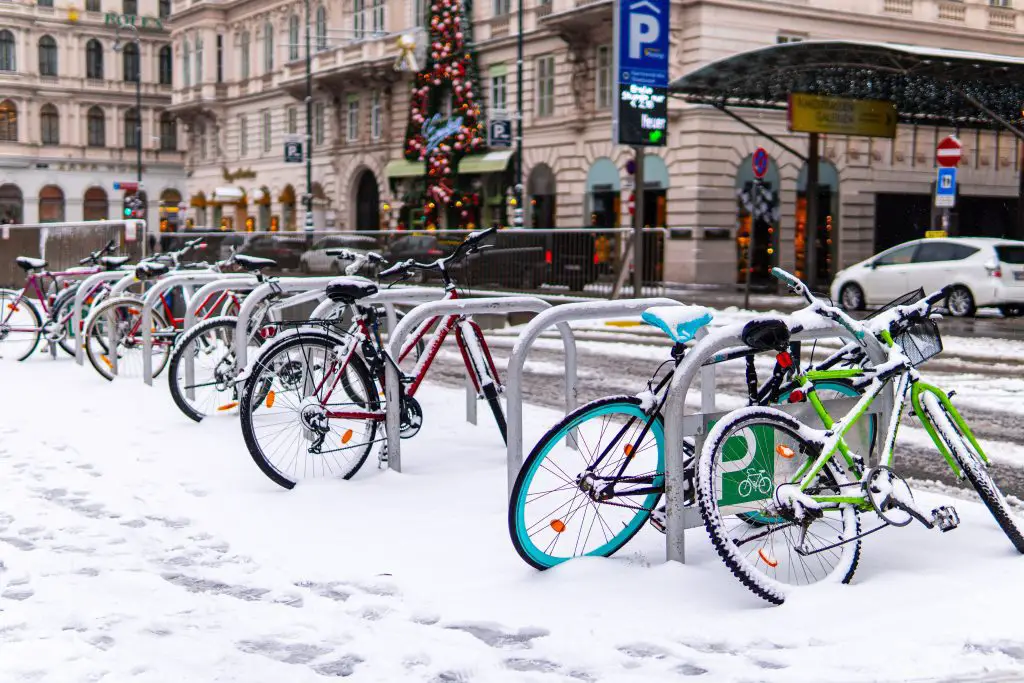Winter is brutal, the ground becomes a freezing white abyss, and the bone-chilling cold is more than enough to test your willpower. But what if your primary mode of transportation is a bike? The challenge of winter cycling is real, and slipping on ice can turn a simple ride into a terrifying experience. How do you navigate this snowy hurdle? Use anti-skid tires!
What are anti-skid tires? They’re your lifesavers when you’re biking in the blistering cold. Anti-skid tires, specially designed with advanced grip technology, dramatically reduce the risk of skidding, making your winter rides safer and less terrifying.
Why did you need anti-skid tires?
Winter cycling requires serious gear. When you’re riding on slicks in the snow, it’s not a matter of if you’ll skid but when. It’s a bit like a scene from Disney’s Bambi on Ice — pretty hilarious for onlookers, but not so much for the rider.

Slicks tires (like thick slicks) are simply not designed for snowy conditions. They lack the necessary tread depth and pattern to grip the snow and ice effectively. If you try to ride on slicks in the snow, it’s like trying to ice skate with tennis shoes — you’re not going to get very far, and you’ll likely take a few tumbles.
So, I took a deep dive into the world of winter bike gear. I needed equipment to keep me warm, see where I’m going, and, most importantly, prevent me from skidding on the icy roads. This led me to discover anti-skid tires.
State Bicycle Co. Black Label 6061

State Bicycle Co. Black Label 6061
How do anti-skid tires work?
Anti-skid tires are the game-changer for winter biking, taking an average winter ride from a terrifying slip and slide to a controlled, safe, and enjoyable activity. You’ll find that these tires come with certain unique features that make them apt for the task.
First, anti-skid tires have a special rubber compound that remains flexible in low temperatures. This flexibility increases the tire’s grip on the road surface, reducing the likelihood of skidding.
Riding fixed gear is about the challenge, the control, and the thrill. What’s more challenging than taking control of your bike in the icy grip of winter?
Second, these tires come with a specially designed tread pattern that increases traction. Some are even equipped with small metal studs (fancy pants carbide studs, as I like to call them) to give you additional grip on icy surfaces.
What’s the difference between studded and non-studded anti-skid tires?
Studded tires offer superior grip on icy surfaces but can be a bit overkill if you’re only dealing with snow and not ice. Non-studded anti-skid tires, on the other hand, are excellent for snowy conditions but may struggle on solid ice.
How may anti-skid tires impact fixed-gear cycling?
Now, I know what you’re thinking: “This is all well and good, but I’m a fixed gear rider. Doesn’t adding anti-skid tires make my ride less authentic?” Hear me out. Riding fixed gear is about the challenge, the control, and the thrill. What’s more challenging than taking control of your bike in the icy grip of winter?
And believe me, that first ride on a well-equipped winter bike? It’s a thrill that’s hard to beat. It’s not about making the ride easier; it’s about making it possible and safe. Think of it as a new challenge, a new element to master. Plus, your Thickslicks won’t feel like slicks anymore when they’re sliding all over the place in the snow!
Anti-skid tires might add a bit more weight to your bike and make your ride noisier. But they give you the control and connection you love about fixies, even in icy conditions.

How do you equip your bike with anti-skid tires?
You’ll be relieved to hear that outfitting your bike with anti-skid tires isn’t as complex as assembling an IKEA furniture piece. It’s more like swapping out the cassette tapes in your old Walkman if you remember doing that! You’ll need to take off the old and pop on the new. Here’s a step-by-step guide:
- Deflate your current tires.
- Use a tire lever to pry the bead of the tire away from the rim.
- Remove the old tire and tube.
- Position the new anti-skid tire on the rim.
- Insert the tube into the new tire.
- Push the bead of the new tire back into the rim.
- Inflate the new tire to the recommended pressure.
Make sure you always have the right tools for the job. A tire lever, a bike pump, and your new anti-skid tires should do the trick.
Here’s a simple table of dos and don’ts to help you navigate your winter biking adventure:
| Dos | Don’ts |
|---|---|
| Do consider your local weather conditions before choosing between studded and non-studded tires | Don’t forget to deflate your tire before removing it from the rim |
| Do ensure you have the correct tire size for your bike | Don’t inflate your new tires beyond the recommended pressure |
| Do give yourself some time to adjust to the new feel of your bike with anti-skid tires | Don’t neglect regular tire checks and maintenance during winter |
Advantages and disadvantages of anti-skid tires
When it comes to fixed-gear bikes, choosing the right tires is crucial for ensuring a safe and enjoyable riding experience. Anti-skid tires, also known as skid-resistant or grippy tires, are specifically designed to enhance traction and reduce the risk of skidding on various road surfaces. However, it’s important to consider both the advantages and disadvantages of these tires before making a decision.
Advantages of anti-skid tires
Anti-skid tires offer several benefits that can greatly improve your fixed-gear biking experience:
- Enhanced Grip: These tires are engineered with special rubber compounds and tread patterns that provide superior grip on both dry and wet surfaces, reducing the chances of sliding or skidding.
- Increased Safety: By improving traction, anti-skid tires help you maintain better control of your bike, especially when cornering or braking abruptly, minimizing the risk of accidents.
- Better Handling: The improved grip allows for more precise steering, giving you a greater sense of control and confidence while navigating different terrains.
- All-Weather Performance: Anti-skid tires excel in adverse weather conditions, such as rain or snow, where regular tires may struggle to maintain grip. They provide increased stability and reduce the likelihood of hydroplaning.
- Longer Lifespan: Due to their durable construction and specialized rubber compounds, anti-skid tires tend to have a longer lifespan than standard tires, saving you money in the long run.
Disadvantages of anti-skid tires
While anti-skid tires offer numerous advantages, there are a few considerations to keep in mind:
- Higher Rolling Resistance: The enhanced grip of anti-skid tires comes at the cost of increased rolling resistance. This means that pedaling requires more effort, which can be tiring, particularly on longer rides.
- Reduced Speed: The improved traction and grip provided by these tires may slightly reduce your overall speed compared to smoother tires. However, the impact on speed is generally minimal for most riders.
- Limited Availability: Anti-skid tires may not be as widely available as regular tires, especially in certain sizes or specialized designs. This could limit your options when it comes to choosing specific tire models or brands.
- Potentially Higher Cost: Due to their specialized construction and materials, anti-skid tires can be more expensive than standard tires. However, the added safety and performance benefits may outweigh the initial investment for many riders.
After weighing all the pros and cons, I’ll put it out there: Yes, anti-skid tires are absolutely worth it. They may not be perfect, but they’re your best bet for a safe and enjoyable winter biking experience. I’d recommend them as strongly as I’d recommend a good helmet or a properly fitted bike. Safety and control are priceless, folks!
If you want even more great tips and information, check out the video.
Frequently asked questions (FAQ)
Do you still have questions about anti-skid tires? Below are some of the most commonly asked questions.
Do anti-skid tires affect speed on fixed-gear bikes?
The added weight of anti-skid tires can indeed slightly affect your speed. However, this difference is often negligible and is generally offset by the increased safety and control these tires offer, especially in slippery conditions.
Can I use anti-skid tires all year round?
While you can use anti-skid tires year-round, they’re especially useful during colder months when roads can get icy or snowy. In warmer months, you might opt for regular tires as they could provide a smoother, quieter ride and last a bit longer.
Is it difficult to install anti-skid tires on my fixed-gear bike?
Installing anti-skid tires isn’t more difficult than fitting regular tires. If you’re handy with basic bike maintenance, you’ll manage just fine. If not, your local bike shop should be able to help you out for a small fee.
Conclusion
We’ve biked down some slippery slopes today, haven’t we? But don’t tire out yet. We’re at the finish line! Did I cover everything you wanted to know? I read and reply to every comment. So, let’s keep the conversation rolling in the comments section below. If you found this blog helpful, don’t keep it under your helmet—share it with a friend! Check out my full blog for more two-wheel talk and tips. Thanks for reading, and keep those wheels turning!
Key takeaways
This article covered anti-skid tires and their application in fixed-gear cycling. Here are some key takeaways:
- Anti-skid tires provide better control, especially on icy surfaces.
- These tires can be a bit noisier and might not last as long as regular tires.
- Anti-skid tires are especially useful in colder, slippery conditions.
- Anti-skid tires offer advantages such as enhanced grip, increased safety, better handling, and improved performance in adverse weather conditions.
- Considerations for anti-skid tires include higher rolling resistance, potentially reduced speed, limited availability in certain sizes or designs, and a potentially higher cost compared to standard tires.















